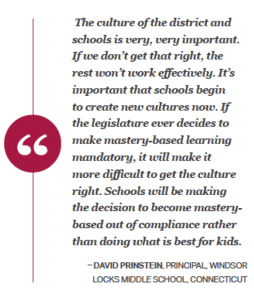Three Lessons Learned from New England States Transitioning to Competency-Based Education
CompetencyWorks Blog
This is the sixth post in the series Reaching the Tipping Point: Insights on Advancing Competency Education in New England.
 What can we learn about state-level strategies from New England states transitioning to competency-based education? At this point in the evolution of competency education, there are a few solid lessons to be learned from the New England region. It is helpful to compare and contrast the different approaches of the states, looking for powerful insights into the considerations of different strategies and approaches, as this provides deeper understanding and can shine a light on what is the best path for a state. Some states, such as Connecticut, may want to create enabling policies, while others, like Maine, New Hampshire, Rhode Island, and Vermont, will contemplate bolder, more comprehensive steps toward transformation.
What can we learn about state-level strategies from New England states transitioning to competency-based education? At this point in the evolution of competency education, there are a few solid lessons to be learned from the New England region. It is helpful to compare and contrast the different approaches of the states, looking for powerful insights into the considerations of different strategies and approaches, as this provides deeper understanding and can shine a light on what is the best path for a state. Some states, such as Connecticut, may want to create enabling policies, while others, like Maine, New Hampshire, Rhode Island, and Vermont, will contemplate bolder, more comprehensive steps toward transformation.
However, context matters: considerations need to include public demand and level of public trust, what is already in place, the degree to which districts and schools have already embraced some or all of the elements of competency education, level of consensus among leadership, competing agenda items, and the structural and financial issues that shape schools, such as district consolidations, funding, and political turmoil.
Three Important Lessons Learned
- Educators turn to competency-based education because it makes sense regardless of the state policy. Given the strong state leadership in establishing comprehensive competency-based policy in most of the New England states, it would be easy to think that state policy is always the first step in making the transition to competency-based education. However, there are innovators and schools considering competency-based education in Massachusetts with little encouragement from state leaders. In Maine, one of the original sources of early innovation were the districts that formed the Maine Collaborative for Customized Learning.
- Policy is important, but not sufficient. Establishing high-leverage policy such as proficiency-based diplomas or credits will direct districts toward competency education. However, it doesn’t mean they will move quickly to implementation or that they will implement it effectively. Creating innovation space doesn’t necessarily produce a groundswell of innovators. Statewide change requires a combination of innovation space, support, networks, and political coverage. Maine provided upfront training to a “coalition of the willing” before passing a policy that created proficiency-based diplomas. Vermont and New Hampshire have extensive support strategies, although they are very different in design. Most importantly, community engagement strategies need to be deployed to provide opportunities for shaping the vision of the district and schools as well as to learn about competency-based education practices.
- Walk the talk by using similar guiding principles as those found in personalized, competency-based districts. It isn’t going to work for states to use traditional change and communication strategies if they want to move beyond the traditional system. For example, it will be difficult, if not impossible, to implement competency-based education through compliance strategies. Compliance assumes that the state knows exactly what should be done when, in fact, there are many ways to design personalized, competency-based models. The paradigm shift is too important to the process of transformation—educators and community members need the opportunity to learn, to reflect, and to decide that this is what they want to do. In addition, the large systemic changes have many implications to be considered. Co-design or collaborative processes that draw on multiple perspectives is a much stronger strategy.
Most importantly, state policymakers and administrators need to hold tightly to a growth mindset. In order to build systems that will create a sustainable competency-based system, we have to believe that educators, education leaders, district leaders, school board members, and state leaders themselves can all learn and build the skills necessary for making the transition.
Download the full report to learn more.
Read the Entire Series:
Post #1 – Reaching the Tipping Point: Insights on Advancing Competency Education in New England
Post #2 – The Every Student Succeeds Act: A Catalyst for Competency Education at Scale?
Post #3 – Five Drivers of Transformation in New England States
Post #4 – The Trouble with Prescriptive Policies When Paradigms are Shifting
Post #5 – A Timeline of K-12 Competency-Based Education Across New England States